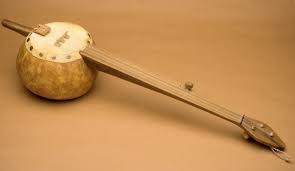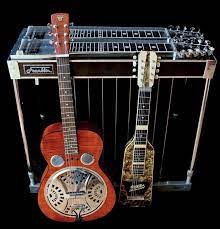day four of Sidetracks And Detours´ inaugural Bluegrass Music in text Festival 2033, looking at what is INSTRUMENTAL TO BLUEGRASS.
day four of Sidetracks And Detours´inuagural Bluegrass Music in text Festival 2033, looking at what is
INSTRUMENTAL TO BLUEGRASS.
Norman Warwick is guided by George Katsanos

George Katsanos (left) is the bassist of Mobvibe and a avid fan of Rock music and Fender Telecasters. When not practicing his bass lines he is busy writing code for web applications. I was delighted to find, in one of his many on-line articles, that he had served as on page tour guide through the instruments that often find themselves in a bluegrass orchestra or band. I followed and hung on his every word so I could recount his points to my readers so that you can look through George´s archives and feel you self the love and expertise that goes into them.
The “classic” bluegrass sound began with the 1945 Monroe band, and it has influenced many musical genres, including modern rock and jazz. The most used bluegrass instruments are banjos, mandolins, steel guitars and resonator guitars. Modern Bluegrass is composed of musical pieces called “breakdowns”, where each instrument takes its turn playing the melody.
That’s the reason why the mentioned bluegrass instruments can both lead and provide accompaniment. Below there’s a list of the most recommended instruments for anyone, willing to get started with this amazing music genre:
Mandolins usually have 4-5 double strings and their sound can be easily recognized. Those are versatile instruments, which are used in various musical genres, ranging from bluegrass to classic music (including Mozart, Mahler and Beethoven pieces). Mandolins are plucked either with fingers or a plectrum.

photo 2 The HBMA-50 Mandoline BK is a great starter. It comes in black body color with chrome hardware, which gives it an elegant look. Its rosewood bridge and fretboard gives the HBMA-50 a well-recognizable, powerful sound, while the basswood body makes the instrument feel solid and reliable. As an acoustic instrument, this mandolin serves well for either home performances or big live performances with an external microphone, facing the body of the instrument. It goes for €58. If you’d like to have the same mandolin with an in-built mic, then consider checking this one:
The HBMA-50E has in-built pick-ups, allowing it to be connected directly to an amp or mixing panel. It also comes with volume and tone control knobs, which are useful if you’re plugging the instrument right into a guitar amp. Nevertheless, it’s still preferable to plug it into a mixing panel or use an EQ pedal in order to bring the treble value up. The low price and great quality of the HBMA-50 and HBMA-50E makes them one of the best starter mandolins. It costs €79.
Ibanez is well known for manufacturing high-quality, durable music instruments. The M510E-BS has inbuilt magnetic pick-ups and two knobs to control the output volume and tone. This model comes in brown sunburst colour, which makes it look genuine and elegant. If you’re willing to acquire an instrument you will be using for many years, then the Ibanez M510E-BS might be the best choice.
On the other hand you might, like Guy Clark, prefer the exciting unpredicatability of Picasso´s Mandolin, but it might be worth tracing that song of Guy´s and giving it a listen so you envisage the kind of danger and advenute and thrills that might await. You can´t be afraid of baggy pants ! (Girl With Mandolin by Picasso shown right).

It’s said that the first banjos were created 6000 years ago. That might explain the fact that banjos are one of the widest used folk musical instruments in the world. While a guitar has a full-covered wood body, banjos have a thin leather/plastic membrane stretched over a metal frame. Another difference is that banjo players use different picking techniques, since every banjo string serves its own purpose (some are used for solo leads, while others are used for chords).
The HBJ-25 is widely praised for having a clear tone and nice sustain. It’s playable from the box, with the obvious tuning needed. If you’re willing to try banjo without investing a lot in the instrument, the HBJ-25 is a great starter – it offers all the basic features any other 5 string banjo has. It goes for €129.
The HBJ-26 has 6 strings (which mean one more bass string than the HBJ-25). Its rosewood fretboard is solid and durable; in fact, rosewood is widely used in high-end guitars. If you’ve tried the HBJ-25 and you feel like you need more bass, then the HBJ-26 might be the perfect choice for you. It costs €138.
Although they look almost like classic guitars, resonator guitars work differently. Long story short, the sound they produce is amplified by the resonator cones, and not by the wooden body (the body does influence the sound quality, though).
There are strictly positive reviews about the N-150CE BK. It’s easy to underrate this guitar because of its low price of €177. Nevertheless, the N-150CE BK is definitely not the “cheap starter”. It sounds loud, responsive and clear. Its looks won’t disappoint you either – the big chromed resonator disk combines greatly with the wood body, making the guitar look outstanding. Due to its metallic parts, this guitar is a bit heavy, but that’s an issue many resonator guitars share. The N-150CE BK also has inbuilt pick-ups, though some users prefer to use an external microphone instead.
This chrome version offers an overall higher sound quality, more depth and durability than the N-150CE BK. The high-quality metal body, rosewood fret-board and maple biscuit bridge is the reason why this guitar is so sturdy. It is recommended to use this guitar with heavy strings and open G or D tuning. It has a good, deep sound and it’s great for gigs and traveling.

There’s no bluegrass without the sound of a steel slider (left) . A steel slider is basically a guitar that was specially designed to be placed on the player’s lap – this way it allows the player to perform slides easily. Also, the slider’s strings don’t get pressed against the fretboard; instead, the player holds a metal slide, which acts as a mobile fret.
The Benton Slider II is a durable and versatile electric steel slider, aimed to perform well in different tunings and with different string gauges. It comes with a single coil pickup and the required volume and tone control knobs. The pack also includes a slider, a tonebar and a gig bag. Considering the good quality of the guitar, all these features make the Benton Slider II the perfect starter. It costs €79
Some players prefer to have their slider guitar to lie on a stand. That’s a good choice for long rehearsal or performances, even though it limits mobility. If you prefer stability over mobility, then you might want to check this option out. This particular stand comes with a gig bag and has adjustable legs. Its cost is €98.
Although we’re used to the idea that high-end instruments cost a lot of money, fact is that you can get a decent instrument on a budget. We’ve mentioned the word “starter” quite often, yet all of the instruments, mentioned here, fit perfectly both for practice and for live performances.
Bluegrass Instruments: A Guide for Beginners (musicngear.com)

The prime source for this article was a piece published on the site above, written by George Katsanos.
In our occasional re-postings Sidetracks And Detours are confident that we are not only sharing with our readers excellent articles written by experts but are also pointing to informed and informative sites readers will re-visit time and again. Of course, we feel sure our readers will also return to our daily not-for-profit knowing that we seek to provide core original material whilst sometimes spotlighting the best pieces from elsewhere, as we engage with genres and practitioners along all the sidetracks & detours we take.

e mail logo The purpose of this daily not-for-profit blog is to deliver news, previews, interviews and reviews from all across the arts to die-hard fans and non- traditional audiences around the world. We are therefore always delighted to receive your own articles here at Sidetracks And Detours. So if you have a favourite artist, event, or venue that you would like to tell us more about just drop a Word document attachment to me at normanwarwick55@gmail.com with a couple of appropriate photographs in a zip folder if you wish. Beiung a not-for-profit organisation we unfortunately cannot pay you but we will always fully attribute any pieces we publish. You therefore might also. like to include a brief autobiography and photograph of yourself in your submission. We look forward to hearing from you.




Leave a Reply
Want to join the discussion?Feel free to contribute!